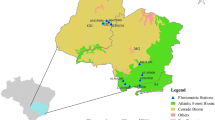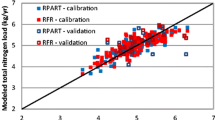Abstract
This paper describes the development and derivation of a methodology for estimating low flow characteristics and yield in small ungauged rural catchments. The methodology has been applied to 184 catchments located in New South Wales and Victoria, in south-eastern Australia. A systems approach was adopted in which multivariate techniques were used to develop relationships between low flow parameters and climatic and land information data.
Similar content being viewed by others
References
Andrews, D. F., 1972, Plots of high dimensional data,Biometrics 28, 125–36.
Boughton, W. C., 1984, A simple model for estimating the water yields of ungauged catchments,Civil Engin. Trans. Inst. Engin. Aust. CE26(2), 83–88.
Bureau of Meteorology, 1988,Climatic Atlas of Australia Australian Govt. Pub. Service, Canberra.
Gan, K. C., McMahon, T. A., and O'Neill., I. C., 1988, Estimation of yields and storages for small rural ungauged catchments,Conf. Agric. Engin., Instit. Engin. Aust. Nat. Conf. Publ. 88/12, pp. 307–310.
Haines, A. T., Finlayson, B. L., and McMahon, T. A., 1988, A global classification of river regimes,Appl. Geog. 8, 255–272.
Hebblethwaite, D. and James, B., 1990, Review of surface water data, Kawarren, Rural Water Commission of Victoria, Investigations Branch Report 1990/45.
Institute of Hydrology, 1980, Low flow studies: (1) Research report; (2) Flow duration curves estimation; (3) Flow frequency curves estimation; (4) Catchment characteristics estimation manual, Institute of Hydrology, Wallingford, U.K.
McMahon, T. A., 1984, Low flow and yield data requirements, inProc. Workshop on Surface Water Resources Data, Aust. Water Resour. Council Conf. Series 10, Australian Govt. Publ. Service, Canberra, 80–124.
Nathan, R. J. and McMahon, T. A., 1990a, Evaluation of automated techniques for baseflow and recession analysis,Water Resour. Res. 26(7), 1465–1473.
Nathan, R. J. and McMahon, T. A., 1990b, Practical aspects of low flow frequency analysis,Water Resour. Res. 26(9), 2135–2141.
Nathan, R. J. and McMahon, T. A., 1990c, The SFB model, Part I — Validation of fixed model parameters,Civil Engin. Trans. Inst. Engin. Aust. CE32(3), 157–161.
Nathan, R. J. and McMahon, T. A., 1990d, The SFB model, part II — Operational considerations,Civil Engin. Trans. Inst. Engin. Aust. CE32(3), 162–166.
Nathan, R. J. and McMahon, T. A., 1991a, Identification of homogeneous regions for the purposes of regionalisation,J. Hydrol. 121, 217–238.
Nathan, R. J. and McMahon, T.A., 1991b, The estimation of low flow characteristics in ungauged catchments: a practical guide, Dept. of Civil and Agric., Engg.; Univ. of Melbourne.
Nathan, R. J. and McMahon, T. A., 1991c, Reply to discussion on ‘Evaluation of automated techniques for base flow and recession analyses’,Water Resour. Res. 27(7), 1783–1784.
Tasker, G. D., 1989, Regionalisation of low flow characteristics using logistics and GLS regression,New Directions for Surface Water Modelling, IAHS Public. 181, pp. 323–331.
Author information
Authors and Affiliations
Rights and permissions
About this article
Cite this article
Nathan, R.J., McMahon, T.A. Estimating low flow characteristics in ungauged catchments. Water Resour Manage 6, 85–100 (1992). https://doi.org/10.1007/BF00872205
Received:
Issue Date:
DOI: https://doi.org/10.1007/BF00872205




